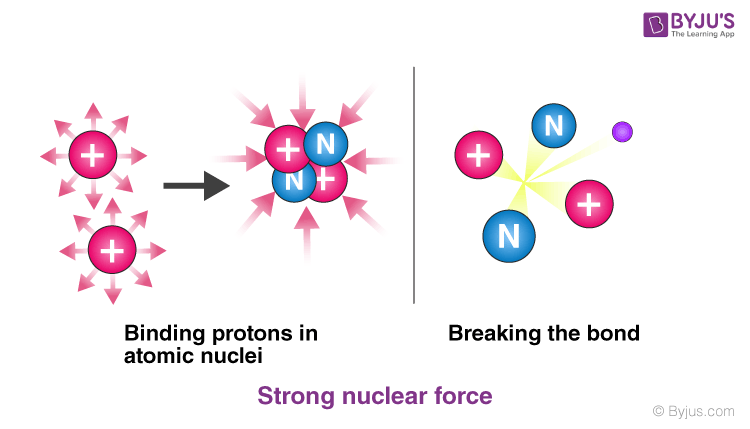The quest to elucidate the intricacies of atomic structure invariably guides us into the realm of fundamental forces. Among these forces, the strong nuclear force—also known as the strong interaction—emerges as the paramount agent binding protons and neutrons in the nucleus. This force is indispensable for the stability of matter and influences various phenomena in the universe, from the very essence of atomic structure to the processes that fuel stars. Through this exploration, we will unveil the nuances of the strong nuclear force, its properties, and its implications on a macrocosmic scale.
To commence our investigation, it is imperative to understand the genesis of the strong nuclear force. At its core, this force is a fundamental interaction that arises from the principles of quantum chromodynamics (QCD). Within this theoretical framework, particles known as quarks—the building blocks of protons and neutrons—interact via the exchange of gluons, which are the mediators of the strong interaction. This exchange not only dictates the behavior of quarks but also ensures the cohesive integrity of atomic nuclei.
The strong nuclear force is uniquely characterized by its extraordinary strength, which is approximately 100 times greater than the electromagnetic force. This potency is crucial in overcoming the electromagnetic repulsion between positively charged protons, allowing them to coexist within the nucleus. However, the strong nuclear force exhibits a remarkable property: it operates effectively at an exceedingly short range, around 1 femtometer (10-15 meters). Beyond this distance, the force diminishes precipitously, showcasing a unique feature of confinement. Quarks only exist in pairs or triplets, forming composite particles such as baryons and mesons, an assertion that marks the distinction between all other fundamental forces in nature.
Moreover, the strong nuclear force is not merely abstract; it manifests profoundly in the context of nuclear stability. The balance of forces within atomic nuclei—specifically the interplay among the strong nuclear force, electromagnetic repulsion, and the weak nuclear force—determines the stability of isotopes. Consider, for instance, the concept of the “valley of stability,” which delineates the isotopes that exhibit resilience against radioactive decay. Nuclei that adequately balance the strong nuclear force and electromagnetic repulsion are inherently stable, while those that do not are often subject to decay through various processes, including beta decay and alpha decay.
To further punctuate the significance of the strong nuclear force, one must explore its implications in nuclear fusion, an essential process that powers stars and enables the nucleosynthesis of heavier elements. In stars, hydrogen nuclei (protons) must overcome their repulsive electrostatic forces to undergo fusion. Facilitated by extreme temperatures and pressures, the strong nuclear force becomes the paramount player, resulting in the formation of helium and the release of vast amounts of energy. This energy production not only sustains stellar lifecycles but is also integral to the creation of the elements that comprise our universe.
This leads us to the exploration of nuclear reactions, which are predominantly governed by the dynamics of the strong nuclear force. The mechanisms behind fission and fusion provide tantalizing insights into energy release and the formation of heavier elements. In nuclear fission, the nucleus of an atom—typically uranium-235 or plutonium-239—absorbs a neutron, leading to a distortion of its shape. The strong nuclear force, although initially holding the nucleons together, can no longer stabilize the nucleus beyond a critical point; this results in the splitting of the nucleus into smaller fragments, alongside the release of additional neutrons and a gripping amount of energy. The exact same principle underlies thermonuclear fusion, underscoring the far-reaching influence of the strong nuclear force across different reactions.
Moreover, recent advancements in particle physics have illuminated even more complex aspects of the strong nuclear force. Experiments conducted at high-energy particle colliders have yielded significant evidence regarding the formation of a quark-gluon plasma—a state of matter theorized to exist shortly after the Big Bang, showcasing a confluence of strong interactions between quarks and gluons in a deconfined state. This discovery not only reaffirms the strong nuclear force as a critical component in the early universe but also invites new inquiries into the fundamental structure of matter itself.
The utility of the strong nuclear force extends beyond theoretical accounts and into practical applications as well. The development of nuclear technology, whether it be for generating energy or for medical purposes—such as in radiation therapies—underscores the paramount importance of understanding this fundamental force. The intricacies of nuclear interactions inform the design of reactors, yielding a myriad of energy generation possibilities that continue to shape modern civilization.
In conclusion, the strong nuclear force is far more than a mere interaction among particles; it is a critical component in the tapestry of the universe, governing the stability of matter, the synthesis of elements, and the dynamic processes within stars. Its profound implications stretch from the minutiae of atomic interactions to the expanses of cosmic phenomena, rendering it a captivating subject of study. By grasping the intricacies of this formidable force, we open the door to untold possibilities and a deeper understanding of the fabric that constitutes our universe. The promise embedded within these investigations not only piques curiosity but also delivers the gravitas of scientific endeavor to comprehend our existence at the most fundamental level.












